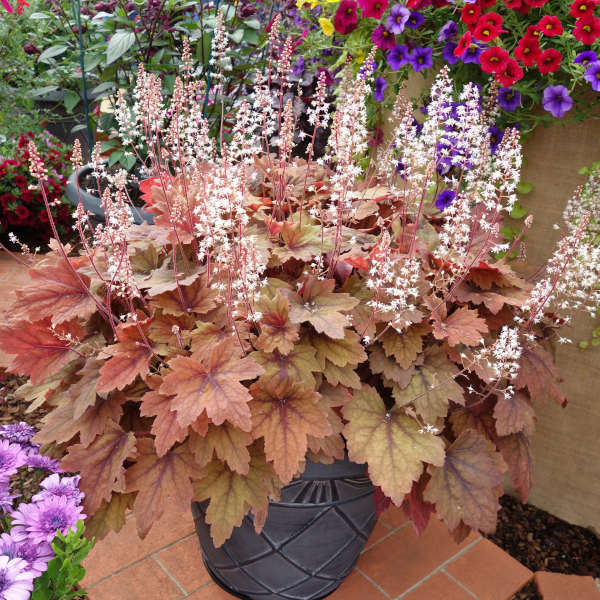How to grow Heuchera
Easy-going, evergreen or semi-evergreen perennials which come in a striking and broad range of foliage colours from black and deep purple to zingy lime and yellow. Nowadays there are some beautifully marked species too which add both pattern and intrigue to the garden all year. Happy in borders and containers where they form rounded compact leafy clumps which offer valuable winter colour when this can be sparse. In summer long stems bearing dainty flowers are produced to give a hazy impact in the garden. Flowers are a great way of attracting bees into the garden and stems have a delicate, frothy impact in a vase.
Plants prefer a spot in dappled or light shade so as not to scorch the foliage, although some like a sunnier spot whilst others adapt well to more shade so do check each variety’s specific needs before planting. An average of 4-6 hours sunlight seems to suit most heuchera with a rule of thumb that the darker leaved ones like more sun and the lighter ones less. These are woodland plants when they grow in the wild and often root in crevices or on slopes so, where feasible, replicate this for dramatic impact. Plants are hardy (-10°C to -20°C) and should not need additional winter protection throughout most of the UK.
Plants are, in the main, native to North America and were brought to Europe in the 15th century by early explorers. Commonly referred to as Alum root or Coral Bells some species are also found in Mexico and one or two in Canada and Russia.
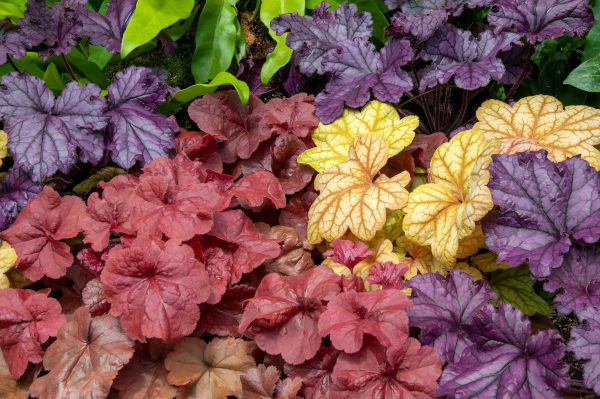
Zantedeschia is a genus of flowering plants from the family Araceae and is native to southern Africa. With a rich history dating back to the Ancient Romans, these deciduous or semi-evergreen perennials have been used as a symbol of celebration. Zantedeschia was Named after Professor Giovanni Zantedeschia, an Italian botanist.
There are two main forms of Zantedeschia: hardy and tender. Hardy forms of the plant can be grown outdoors, enjoy moist soil and full sun or partially shaded conditions - these are known as Arum lilies. Tender forms of Zantedeschia prefer being grown in containers or pots and should be brought inside over the winter - these are known as Calla lilies.
With tuberous flora in all colours from whites, yellows and oranges to deep reds and purples, Zantedeschias are not to be overlooked in any garden, as long as they have sufficient sunlight to grow in.
Ready to learn more about growing Zantedeschia? Read on for all there is to know...

Key Information
Soil pH
Position
Hardiness

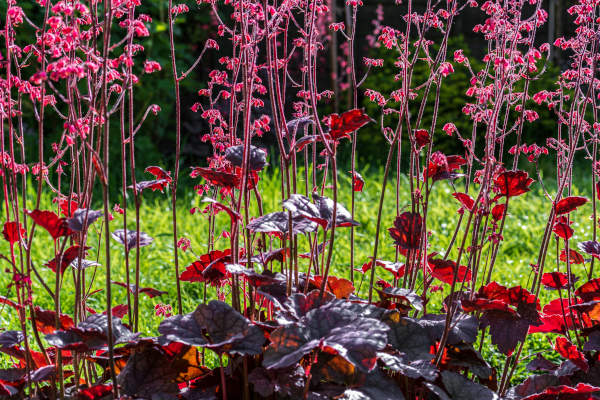
Where & when to plant Heuchera
Position - Dappled shade or sun
Soil - Well-drained, moderately fertile soil of any kind. Wet and claggy soil is best avoided.
Flowering Period - Summer
Hardiness - Mainly H5 and H6
Heucheras are compact, with foliage mounds reaching around 20–30cm in height and spread, this makes them ideal for small spaces and large containers as well as mixed borders. Once established, many heucheras cope well in dry shade although they will need watering during times of drought, this quality means they are valuable as groundcover under trees.
For best results, plant in spring or autumn, when the ground is warm, so plants have the best chance to settle in. You can, however, plant at any time of year providing the ground is not flooded or frozen. Take extra care to keep on top of watering if you plant in summer though.
Plants are excellent to the front of a border or edge of a path where the fabulous foliage can take centre stage. Also happy in a pot – either as a focal plant or mixed with other bedding for a carefully co-ordinated display.
How to plant Heuchera
In the ground
- Clear the chosen area of weeds.
- Dig a planting hole several times larger than the root ball as this will encourage roots, and your plant, to spread outwards. Now is the time to give your soil a boost with the addition of plenty of well-rotted organic matter, and, if liable to sit wet, plenty of horticultural grit.
- Place the plant in the hole, ensuring the top of the root ball sits level with the surface of the soil. Too low and the plant may rot, too high and the roots can dry out.
- Backfill with soil and firm in gently.
- Soak well with water.
In a container
- Choose an appropriate container, ensuring there are plenty of drainage holes.
- It can be worth potting up large containers in situ to save yourself the trouble of moving once full.
- Use a good quality potting compost with some horticultural grit mixed in, and, if not already present in the compost (check the description on the bag) some slow-release plant food.
- Start by partially filling the pot with compost; enough so that when placed on it the upper surface of the root balls are about 3cm lower than the top of the pot.
- Infill all the space surrounding the root balls with compost, firming down with your fingers then adding a little more so the plants are held tight.
- Pick up the pot (if you can!) and lightly tap on the potting bench or ground a few times to help further settle the compost around the plant.
- Soak well with water.
- A mulch with horticultural grit will look attractive and help to prevent a ‘cap’ or crust forming on the top of the compost (something container plants can suffer due to the artificial nature of their watering).

What to plant with Heuchera
This of course depends very much on both personal taste and where you choose to locate your heuchera, be that in the border, under shrubs and trees or in a container. Also bear in mind the foliage colour and if you are looking for a contrasting impact or a blend of similar colours.
As a general guide both tiarella and heucherellas are closely related to heuchera and make fabulous companion plants. Hostas and ferns also enhance the foliage by creating contrasting colour and form whilst any number of flowering perennials will bring bright colour and exuberance in either shady or sunny spots dependent on your particular heuchera’s needs.

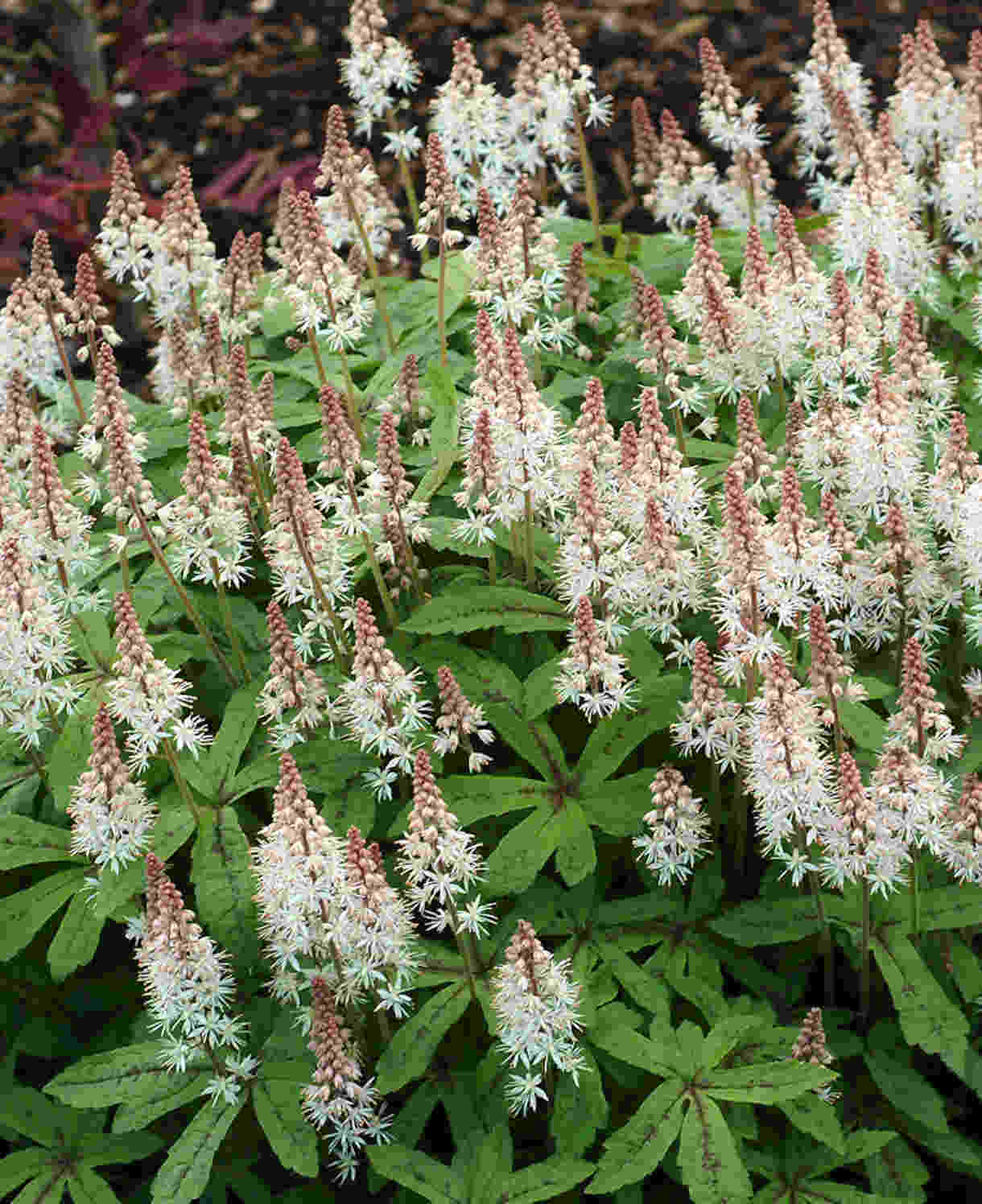
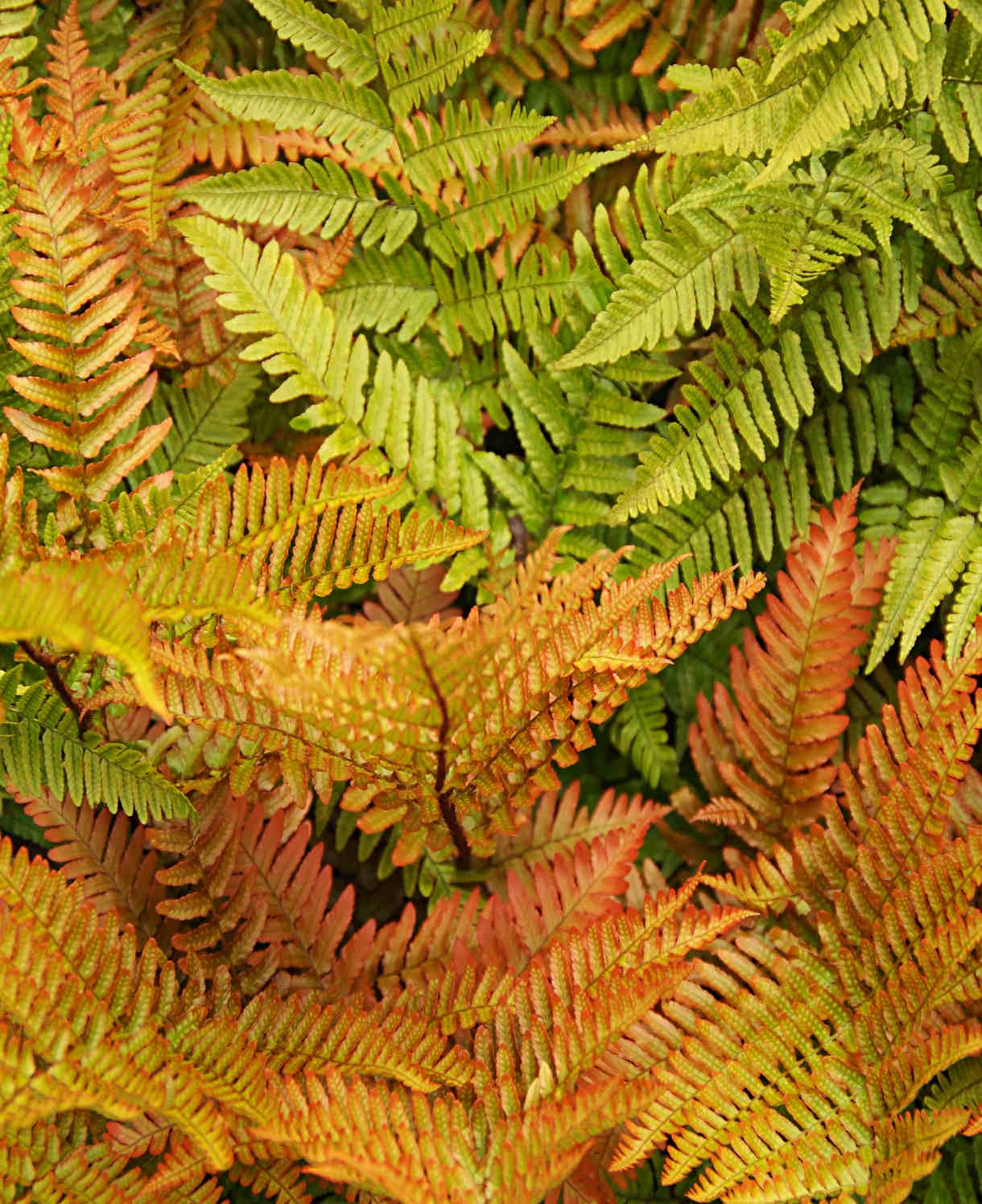
How to care for Heuchera
Pruning and Deadheading
No real pruning is required – simply snip out any dead or tatty leaves and faded flower stems. In order to keep the clumps looking their best, you can cut out any dead or damaged leaves at the base of their stems at any time of year. Evergreen heucheras form a leafy clump all year round, but individual leaves will die or start to look tatty with age, remove these at the base. In colder parts of the UK, the leaves of some cultivars may die off over winter we recommend you resist the urge to tidy up all the dead leaves until spring as they protect the crown of the plant over winter, as well as offering winter shelter to insects.
Deadheading or removing spent flowers to encourage more blooms and prevent seed production can be done as each stems fades if you wish. Alternatively, once the display is over, trim off all the flower stems at the base to ensure energy is not wasted on seeds but focused on more flowers and fresh, vigorous foliage.
Watering
Water newly planted shrubs regularly during their first summer until they establish a good root structure. When watering try to avoid wetting the leaves as this can encourage rotting and fungal growth. Aside from this established heuchera should only need watering in long dry spells although container plants will need regular checking as they dry out more quickly but dislike being waterlogged. If pots are becoming soggy over winter then move to a drier spot such as underneath a wall or fence where they get some protection from heavy rain. Keeping plants fairly dry over winter will help prevent rot at the roots.
Cold Protection
Plants should be hardy enough to cope with winter temperatures in the majority of the UK however, if they are planted in containers, keeping them relatively dry (as above) should assist. Remember plants in pots are more susceptible to cold so huddle them together in a sheltered spot for best results from overwintering. You can also move them into a cold frame or unheated greenhouse and raise them above ground level on bricks or pot feet if you are concerned.
Mulching
Lay a thick mulch of organic matter (such as garden compost) around the plants each spring. This will help to deter weeds and hold moisture in the soil through summer. Remember to leave a gap around the crown of the plant to avoid rotting. Additionally, heuchera are prone to lifting out of the ground over winter if the soil freezes or heavy rain washes light soils from around the fleshy stems, so mulching in spring also helps to fill any gaps that have developed around the roots.
Feeding
Heucheras growing in borders don’t generally need feeding. Plants in containers will, however, benefit from regular liquid feeds in spring and summer as the compost runs out of nutrients after a few weeks. An annual top-dressing will also assist with this.
Pests and Diseases
Generally healthy and trouble free, heuchera can be susceptible to leaf scorch (particularly the paler varieties), vine weevils – especially if grown in pots – and heuchera rust. Sufficient air circulation and ensuring you water the soil not the foliage should assist.
How to propagate Heuchera
You will find that you heuchera need dividing every three years or so to keep them healthy. The best time to do this is in late spring as they start to shoot again. The process is straightforward and gives you more plants to swap or spread throughout your own garden.
- Simply dig up the clump and pull off several of the small, vigorous sections around the edge. Ensure each section has several roots and two or three healthy shoots
- Plant these smaller sections up in individual pots of free-draining compost with added grit. Discard the spent woody centre of the parent plant.
- Place in a sheltered, shady spot for roots to develop. Water little and often – particularly in hot weather. Ensure they do not sit in water however as this will encourage rot.
- New plants will be replicas of the parent plant.
Common Heuchera questions
Do heuchera prefer sun or shade?
Heuchera like a mix of the two – darker varieties being more sun tolerant than their paler cousins.
Do heuchera die back in winter?
They are evergreen or semi-evergreen plants which are resilient and hardy enough for most areas of the UK. If the foliage does die back, it will resprout again the following spring on healthy plants.
Should you cut back heuchera?
No, a simply tidy of any straggly foliage in spring should suffice. Flower stems can be removed as the blooms fade.
Do heuchera spread?
Once each variety reaches its mature height and spread it will not grow any further. However, plants can be propagated by division every 3 or 4 years and each plant will then be a direct replica of its parent.
